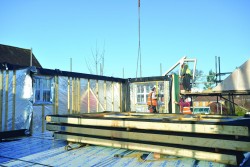Is offsite construction the answer to the delivery challenge faced by the UK Construction Industry? A recent debate hosted by The Fabric First Academy posed this question to a panel of industry experts…
With turnover predicted to reach £7billion by 2018 has the offsite construction sector finally found a place on the mainstream construction agenda?
Could it indeed make the difference to the UK construction industry in its quest to deliver 200,000 new homes per year as well as new schools, student accommodation, and commercial buildings?
The answer to these questions were the topic of two very lively debates at the recent inaugural Offsite Construction Show. The debates were hosted by The Fabric First Academy, for whom the STA has worked since its inception in 2013 and is a true advocate of Fabric First as a construction philosophy in its own right.
Mike Stevenson Development Director of founding partner Sidey said: “What we didn’t want was simply advocates of offsite construction saying how good it was – in fact we wanted the opposite. We wanted to find out what a cross-section of industry people really thought about it. I think it is fair to say that those who attended didn’t go home disappointed, and hopefully they went away with more information and knowledge than they came with.
“Indeed knowledge is a great place to start. We asked the question as to why – although the offsite sector is on course to hit £7billion by 2018 – there was still a resistance or reluctance to engage with this method of construction amongst so many.
“The view from the panel was that there was a real knowledge gap when it came to offsite methods and understanding the achievable benefits of building this way. Starting right at the beginning with architecture and design it was recognised that offsite did not form a big enough part of their learning, and very few architect’s practices actually design with offsite in mind from the outset; more so the appointed contractor looks at already agreed designs and only then see if offsite construction methods might be suitable to bring the scheme to life.
“This is a really key point; with so many sites now in tight inner city and urban locations the restrictions are such that building traditionally is often at best extremely difficult & problematic but at times just unfeasible. It is these restrictions – unaddressed at the outset – which can lead to costs running away from the agreed budget, and delivery times slipping away.
“For clients facing the twin pressures of budget constraint and needing to deliver quickly budget slippage is simply not acceptable, and neither is late delivery with the demands upon them to provide accommodation for a growing population in need of their support. Indeed it is the very essence of what offsite construction can bring – cost and delivery predictability which is seeing more and more people sit up and take notice.
“But perhaps the biggest debate was why does there appear to be such a resistance at constructor level to engaging with offsite and then seeing it through to delivery? Clearly there are many of the major construction companies now exploring offsite fully as they start to understand the benefits of cost predictability and delivery against those of traditional building methods and the need to guarantee their clients exactly what they ask for to an acceptable standard, on time and to budget.
“Coming out loud and clear from the debates was the on-going disconnect between design teams and construction teams. Too few of the buildings which are developed for offsite construction actually reach the site stages still as offsite manufactured schemes; yet the implications of this have been proven to be significant – with disappointed clients being upper most.
“Undoubtedly design teams are increasingly starting to work collaboratively with the offsite sector to specify developed solutions which will deliver ‘as built’ buildings which perform as they were specified and designed to do in the first place, thus closing the renowned performance gap of circa 20%. This is in addition to projects delivered on time and to budget. Clearly this is a debate which is going to run and run.”
The discussion panel consisted of: Mike Stevenson, Development Director of Sidey, Darren Richards of Cogent Consulting, Robert Clarke, Fusion Building Solutions, Jim Roach ARV Solutions, John Skivington LHC, Paul Neep, Architype Architects, Paul Wright, Tremco Illbruck and Dr Robert Hairstans, Institute for Sustainable Construction.
For more information on the Fabric First Academy visit: www.fabricfirstacademy.co.uk









